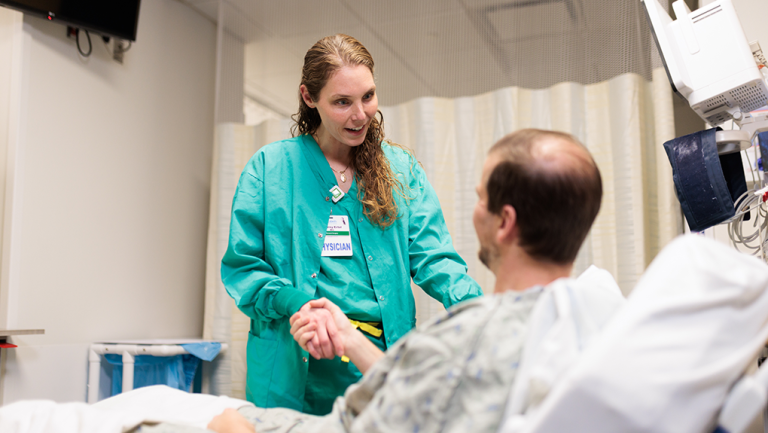Few people give their gallbladder — a small, pear-shaped organ beneath the liver that stores bile for digestion — a second thought when it works properly.
But if gallstones or other gallbladder-related problems arise, the resulting abdominal pain can severely disrupt day-to-day life. When that occurs, removing the gallbladder laparoscopically may provide the simplest, fastest symptom resolution.
Conditions That Require Gallbladder Removal Surgery
Doctors often recommend a cholecystectomy, surgery to remove the gallbladder, for patients experiencing severe pain from gallstones. Gallstones are small, hard deposits that can form in the gallbladder. Roughly 10% to 15% of adults have gallstones, according to the National Institute of Diabetes and Digestive and Kidney Diseases.
In most people, gallstones cause no major symptoms and do not require treatment. In some cases, though, gallstones can block a person’s bile duct. This causes sharp abdominal pain. Patients who experience severe or frequent gallbladder blockage may require gallbladder removal surgery.
Patients with gallbladder cancer or chronic cholecystitis (gallbladder inflammation) may also require gallbladder removal surgery. Fortunately, people can live full, healthy lives without their gallbladder.
The Advantages of Laparoscopic Gallbladder Surgery
If you need gallbladder removal surgery, a laparoscopic procedure can reduce recovery time.
Laparoscopic surgery is a minimally invasive surgery. It uses a laparoscope, a thin tube equipped with a camera and light. The laparoscope conveys images of the patient’s internal organs onto a viewing screen. This allows surgeons to perform abdominal surgery using only small incisions of ½-inch or less.
“Because it involves smaller incisions, laparoscopic surgery results in less trauma and blood loss. That means less pain and faster healing time for patients,” explains Dr. Audrey Ertel, MD, a General Surgeon practicing at St. Elizabeth.
Studies show that laparoscopic surgery can also help patients enjoy a shorter hospital stay and a quicker return to their usual day-to-day activities, compared to traditional surgery. Given these benefits, physicians today perform more than 90% of gallbladder removal surgeries in the U.S. laparoscopically, according to the National Library of Medicine.
“A laparoscopic approach has many advantages. I generally recommend it for all my patients who need gallbladder removal surgery,” Dr. Ertel says. “We tend to use traditional (Open or Large-Incision) surgery for gallbladder removal only when we can’t perform laparoscopic surgery safely due to abdominal scarring or other complications.”
What to Expect During Laparoscopic Gallbladder Surgery
During laparoscopic surgery, a provider puts the patient to sleep using general anesthesia. Then, the surgical team inflates the patient’s abdomen with carbon dioxide gas. This makes it easier to view the gallbladder and other internal organs.
The surgeon makes three or more small incisions into the patient’s abdomen to insert the laparoscope and other surgical tools, and then uses these tools to cut the tissues connecting the gallbladder to the liver and surrounding digestive tract. Then, the gallbladder is removed through the small incision.
After gallbladder removal, the team releases the carbon dioxide to deflate the patient’s abdomen. As a final step, the surgeon uses surgical sutures to close the incisions.
Most laparoscopic gallbladder removal surgeries last 60 to 90 minutes. Many patients can return home on the same day.
Recovery from Laparoscopic Gallbladder Surgery
Recovery takes about two weeks. After that, most patients can fully return to their normal activities.
Providers consider laparoscopic gallbladder removal a routine, low-risk procedure. Still, all surgeries have some risk. You should watch for signs of rare, post-surgery complications, including infection. These include:
- Fever.
- Inability to have a bowel movement for more than three days or diarrhea that lasts more than three days.
- Nausea or vomiting.
- Persistent or worsening abdominal pain.
- Redness, swelling or bleeding at the incision site.
- Yellowing of the skin or eyes.
“Most patients have no long-term serious effects from gallbladder removal,” says Dr. Ertel. “The liver produces bile for normal digestion, even without the gallbladder.”
Some patients report experiencing bloating, diarrhea or other digestive challenges immediately after gallbladder removal. These side effects can be more severe after eating high-fat foods or heavy meals. Symptoms usually diminish over time. Most patients can return to their usual diets after a few weeks.
“In general, laparoscopic gallbladder removal offers a safe and effective treatment for chronic gallstones or other gallbladder complications,” Dr. Ertel says. “By removing the gallbladder, we can keep patients from experiencing the pain and frustration of persistent, continued gallstone attacks.”
If you are experiencing gallbladder pain, call us at (859) 301-2663 to schedule a consultation or visit our General Surgery page to learn more.

